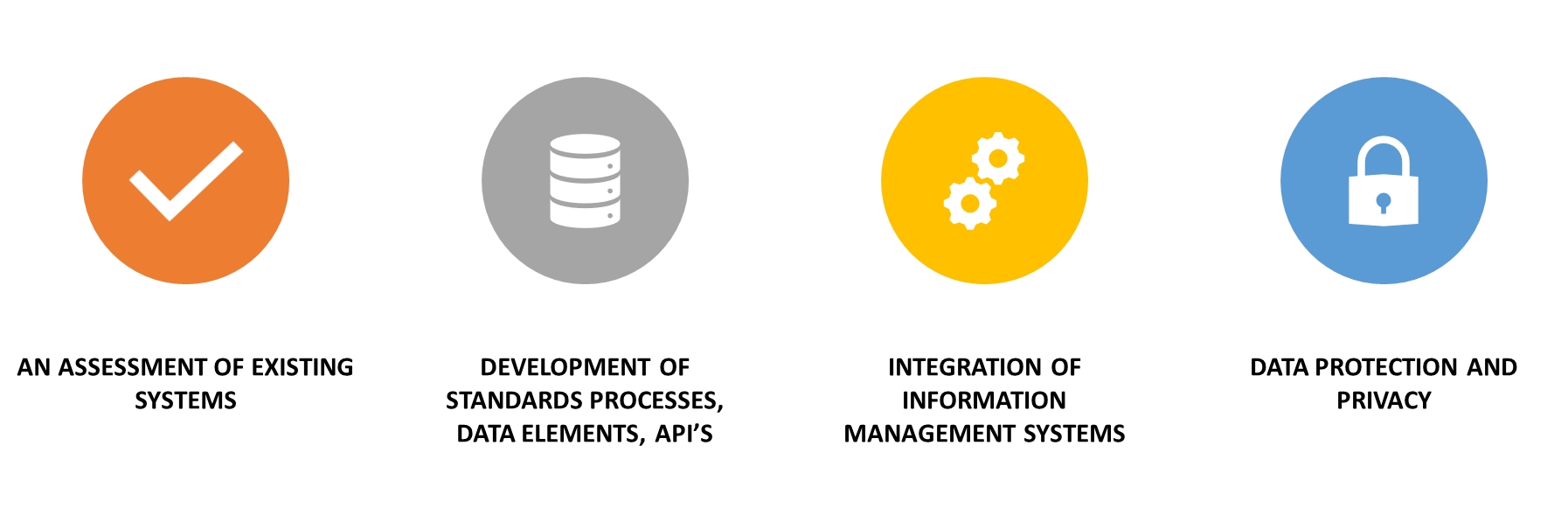Introduction
Note: The standards focus on the interoperability requirements between disability registries (DRs) and social protection (SP) systems. They present examples of case use on the type of information that may be required from SP systems by DRs, and vice versa, to enable more inclusive social protection and to optimise support for persons with disabilities (PWDs) who are seeking and have been granted official disability status in accordance with national laws and regulations. The information available in DRs varies widely between countries, and the standards are based on what has been observed in a diverse array of countries, so as to enable practical interoperability with SP systems in different contexts. The standards do not cover how to build a DR or interoperability with other systems such as healthcare MISs.
A disability registry (DR), sometimes called a disability MIS, consolidates data on the individuals who have applied for and have been granted official disability status or disability certification. Some registries may also contain information about individuals who have applied and been assessed, but have not been deemed eligible, for disability status. The type of information recorded in the DR varies widely between countries, depending on the criteria related to disability certification, the information collected during the disability assessment, and the decision about which information will be recorded in the DR. The UN Committee on the Rights of Persons with Disabilities has consistently recommended that countries consider the barriers and support requirements of the individual in the disability assessment, and not only the impairments.
The goal of a DR is to provide useful information about individual holders of disability status to facilitate access to relevant schemes and services and enhance case management. The DR can also support central and local governments in planning and resourcing for disability support benefits and services.
A DR is distinct from a social registry. While a social registry will hold a list of all people and/or households registered (and, hence, potentially eligible to receive benefits), a DR will only hold data on individuals who have applied for and been granted official disability status.
A DR has a number of objectives, including, but not limited to, the following:
Social assistance: A DR enables the better identification of children and adults with disabilities who are seeking disability related support, allowing governments and authorised organisations to provide targeted services such as financial aid, care and support services and facilitate access to health care, rehabilitation, assistive technology, and education, among other things.
Personalised support plans: With better data on the type of functional difficulties, support requirements and barriers, social workers and case managers can develop, with the person (and also with their families in case of children and adults with very high support needs), a personalised care and support plan to address their specific needs.
Informed decision making: In conjunction with other statistical data, a DR can provide more granular information, which can help policymakers better understand the scope, extent and level of related difficulties and support the requirements of the diverse array of persons with disabilities in their population.
Benchmarking and evaluation: A DR provide a basis for benchmarking the effectiveness of disability programmes and services over time. It can also help assess the extent to which existing mainstream social protection programmes include persons with disabilities.
Optimised service delivery: With detailed information on the situation and support requirements of individuals with disabilities, resources can be allocated more efficiently, ensuring that those in need receive timely and appropriate support.
Cost-effectiveness: A DR can help optimise the use of public resources by improving the accuracy of targeting and the prioritisation of support to those who need it most, facilitating access to available schemes and services, and preventing undue duplication in support.
Enforcement of rights: A DR helps ensure that individuals with disabilities are identified officially and can access their legal rights and entitlements. It also facilitates, but is not required for, anti-discrimination protection and provision of reasonable accommodation.
Monitoring and accountability: A DR aggregates and synthesises data across various social protection programmes.
Disaster preparedness and response: A DR can help identify people who are in need of accessible warning information and communication, as well as specific support for evacuation and shelter. It enables prompt and targeted expansion of cash and in-kind support in response to crisis.
Interoperability between SP System and DR
DRs can assist with planning, coordination and monitoring across the entire SP system. A DR can be both an analytical and operational tool. It can also help to coordinate services, streamline enrolment processes for persons with disabilities, improve service delivery, and enhance the overall efficiency of social protection programmes. A DR can also help advance planning for supporting people with disabilities in emergency situations, for example, for evacuation plans.
Interoperability between SP systems and a DR is crucial for creating an integrated and efficient SP system. By enabling seamless data exchange and communication between these systems, interoperability ensures that information about persons with disabilities is accurately captured, shared, and used across various services and programmes. This connection can help to improve the accessibility of benefits and services for persons with disabilities, including both mainstream and disability-specific benefits and services, personalised service delivery, and comprehensive monitoring of the social protection landscape. Additionally, interoperability enhances the ability to track the impact of social interventions and avoid the duplication of services, fostering a more inclusive and responsive social protection system.

Last updated
Was this helpful?

